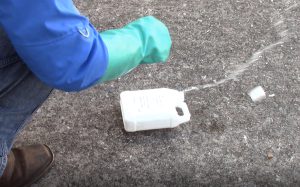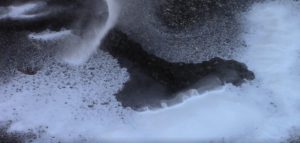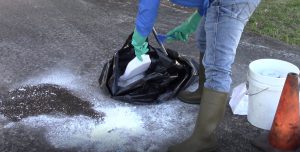 This week in Florida we are dealing with a late season hurricane. It’s very rare to have one like this so late, but as Floridian’s we have learned to expect the unexpected. You might be wondering how in the world does a hurricane relate to pesticide safety? Well dear reader let us find out how to prepare for When Disaster Strikes and learn How to Cleanup a Pesticide Spill.
This week in Florida we are dealing with a late season hurricane. It’s very rare to have one like this so late, but as Floridian’s we have learned to expect the unexpected. You might be wondering how in the world does a hurricane relate to pesticide safety? Well dear reader let us find out how to prepare for When Disaster Strikes and learn How to Cleanup a Pesticide Spill.
The oft repeated phrase from August to November in Florida is “Prepare for the worst and hope for the best”. Hurricanes allow some time to get ready for the chaos they bring. However there is not enough time if you weren’t prepared with a plan ahead of time. Preparation begins BEFORE a storm even has a name. Well-seasoned Floridians have it down to a science and can calmly deal with mother nature’s worst. That same principle can work well for more than just storm readiness, yes working with pesticides can benefit from a plan.
There is nothing people can do to stop a hurricane, but with pesticides we have much more control to prevent spills. Proper pesticide storage, securing pesticides for transport, routine equipment maintenance and deliberate attention during application can greatly reduce the likelihood of a spill. However, even with all that in place accidents can still happen. Unlike a hurricane, you may not have any warning a spill is coming. Disaster still strikes without warning but it does NOT mean that you can’t prepare for the unexpected and cleanup a pesticide spill.
Knowing what steps to take if a pesticide spills and practicing those steps can greatly enhance your efficacy in cleaning a spill. It becomes second nature, and the stress and chaos of an actual spill won’t catch you off guard. So, to best prepare you must know the 3 C’s of pesticide spill management.
Control
First control the source of the spill. This prevents the spill from continuing and making matters worse. Turn the jug right side up, turn off the pump, or otherwise stop the active source of the leak. Stop the source of the spill. BEFORE you do any of that you MUST ensure you have on the proper personal protective equipment (PPE). This will protect you from the hazard a spill poses and greatly reduce your chance of exposure. It is hard to fight the instinct to immediately stop the spill. Protecting yourself MUST come first and it is why practicing before a spill is so important. Now that you have stopped the spill from continuing it is time for the next C…
Contain
Now that we have stopped the spill, lets keep it from spreading and getting worse. The primary concern is to ensure it doesn’t get into water or go down any drains. There are many ways to stop the spread, the key is to find the leading edge of the spill and block it. Activated charcoal “socks”, or absorbent material like clay or kitty litter, or even good old dirt work as methods to stop the spread. The point is to identify where it is spreading, block it, and prioritize keeping it from water or drains. Now the chaos has subsided a little. The spill is stopped and not going anywhere, it is time to calmly continue to…
Cleanup
The spill has stopped and isn’t spreading, but it still needs to be eliminated. You need to absorb the material, collect it, and then dispose of it properly. You can find spill kits that have chemical absorbent material, similar to the polymers found in diapers which can be spread on the spill and then be swept up. Quick dry clay materials, or other absorbents used for oil clean up can work as well. Kitty litter is also an option, or again, good old dirt. Cover the area completely with the absorbent material and carefully sweep it up and collect this material in a double bagged garbage bag. You may need to use absorbent material more than once. Be careful to keep your PPE on during this entire process and avoid sweeping too hard so as not to spread contaminated dust. The material is absorbed and swept away it is time to use soap and water to clean the area one final time. These are the traditional 3 C’s of pesticide spill cleanup, but there is a 4th c to consider…
Contact
If a spill is large enough, is a spill of classified hazardous materials, is on a public roadway, gets into drains, into water, or is significant a risk enough, you need to call someone. Here is a list of people in Florida who should be notified:
- Your supervisor or other proper personnel
- CHEMTREC (Chemical Transportation Emergency Center) 1-800-262-8200
- Florida Department of Environmental Protection: 850-245-2118
- Florida Department of Agriculture and Consumer Services (FDACS): 850-617-7917
- Local Police
In this instance being prepared with copies of the pesticide label and safety data sheets (SDS) will help in any cleanup. Until authorities arrive you may also need to block and secure the area of the spill. If in doubt always reach out. Now we have finished all the C’s, we must move on in the alphabet to….
Dispose
You now have all this pesticide waste; how do you dispose of it? If it is possible, it is legal to apply the cleaned-up pesticide to a site in a manner approved on the label. Ensure you don’t exceed maximum label rates or violate any other provision on the label. If you need to transport that waste in order to do so, seal up the bag/container the contaminants are in and tape a copy of the label to that bag. If you aren’t able to dispose of it properly you would need to dispose of it as hazardous waste. Contact your local authorities (or contact FDACS) to ensure you do so properly.
Conclusion
I couldn’t help myself, I needed to communicate one final C…conclusion. Proper planning and preparation can greatly reduce the chance of a pesticide spill, but practice will truly prepare you for one when it happens. The first time to think about what do when there is a spill is NOT when one is happening. Build a spill kit, make a plan, practice that plan and you will be prepared for When Disaster Strikes and know How to Cleanup a Pesticide Spill.
Click To Subscribe
Useful Links:
https://edis.ifas.ufl.edu/publication/PI196 Spill Kits
https://edis.ifas.ufl.edu/publication/PI258 Fires and Spills
https://edis.ifas.ufl.edu/publication/PI010 Hazardous Disposal
 0
0



